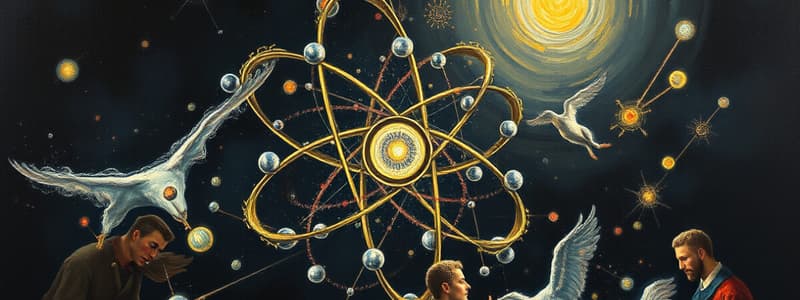Podcast
Questions and Answers
What represents the charge of a proton?
What represents the charge of a proton?
- Positive charge (correct)
- Neutral charge
- Variable charge
- Negative charge
Which experiment determined the charge of the electron?
Which experiment determined the charge of the electron?
- Millikan's oil-drop experiment (correct)
- Thomson's cathode ray experiment
- Rutherford's gold foil experiment
- Becquerel's radioactivity experiment
What is the relationship between protons and atomic number?
What is the relationship between protons and atomic number?
- Atomic number equals the mass number of an atom.
- Atomic number is the number of protons in an atom. (correct)
- Atomic number is the number of electrons in a neutral atom.
- Atomic number is the total charge of protons.
What distinguishes isotopes of the same element?
What distinguishes isotopes of the same element?
Which of the following statements is true regarding atoms?
Which of the following statements is true regarding atoms?
What characteristic defines the mass number of an atom?
What characteristic defines the mass number of an atom?
Which of the following best describes the discoveries leading to the atomic model?
Which of the following best describes the discoveries leading to the atomic model?
What unit is commonly used to express the dimensions of atoms?
What unit is commonly used to express the dimensions of atoms?
What is the primary function of a mass spectrometer in chemistry?
What is the primary function of a mass spectrometer in chemistry?
What distinguishes metals from nonmetals on the periodic table?
What distinguishes metals from nonmetals on the periodic table?
What type of molecule consists of two atoms?
What type of molecule consists of two atoms?
Which formula provides the actual numbers of each type of atom in a molecule?
Which formula provides the actual numbers of each type of atom in a molecule?
Which of the following is true about ionic compounds?
Which of the following is true about ionic compounds?
What is the naming convention for cations formed from metal atoms?
What is the naming convention for cations formed from metal atoms?
What is a characteristic of monatomic anions?
What is a characteristic of monatomic anions?
What are organic compounds primarily characterized by?
What are organic compounds primarily characterized by?
Which of the following correctly describes the use of empirical formulas?
Which of the following correctly describes the use of empirical formulas?
What describes polyatomic ions in chemistry?
What describes polyatomic ions in chemistry?
Flashcards are hidden until you start studying
Study Notes
Atomic Structure
- Atoms are the fundamental units of matter, made up of subatomic particles.
- Subatomic particles include protons, neutrons, and electrons, with protons and neutrons located in the nucleus and electrons orbiting around it.
- Charged particles behave according to electromagnetic principles: like charges repel and opposite charges attract.
Notable Experiments
- Thomson's cathode ray experiments revealed the electron, establishing its charge-to-mass ratio.
- Millikan's oil-drop experiment quantified the charge of the electron.
- Becquerel discovered radioactivity, confirming atomic substructure.
- Rutherford's gold foil experiment led to the nuclear model, highlighting a dense, positively charged nucleus.
Atomic Characteristics
- Electronic charge, denoted as e, is the charge magnitude of an electron, with protons having an equal but positive charge.
- Atomic mass is measured in atomic mass units (amu); common dimension is angstroms for atomic sizes.
- Atomic number defines an element’s identity, representing the number of protons in the nucleus.
- Mass number equals the total number of protons and neutrons; isotopes are variants of an element differing in mass number.
Atomic Mass and Weight
- The atomic mass scale is anchored by assigning 12 amu to carbon-12.
- Atomic weight—the average mass of an element—is derived from isotope masses and abundances.
- Mass spectrometry is a primary method for accurately measuring atomic and molecular weights.
The Periodic Table
- The periodic table organizes elements by atomic number, grouping elements with similar properties in vertical columns (groups) and horizontal rows (periods).
- Metals occupy the left and central areas, with nonmetals on the upper right; metalloids are found along the dividing line between metals and nonmetals.
Molecular Compounds
- Atoms can combine to create molecules; molecular compounds typically consist solely of nonmetals.
- Diatomic molecules contain two atoms, and the substance's composition is described by its chemical formula.
- Empirical formulas indicate relative atom numbers; molecular formulas show exact quantities, while structural formulas depict atom connectivity.
Ions and Ionic Compounds
- Atoms can lose or gain electrons, forming ions: metals form cations (positively charged), while nonmetals form anions (negatively charged).
- Ionic compounds consist of cations and anions, remaining electrically neutral overall, often containing both metal and nonmetal elements.
- Polyatomic ions are charged groups of covalently bonded atoms, and chemical formulas for ionic compounds are written based on ion charges.
Chemical Nomenclature
- The systematic naming rules for ionic compounds require naming cations first, followed by anions, with additional considerations for multiple metal ion charges using Roman numerals.
- Monatomic anions typically end in -ide, while oxyanions (polyatomic that contain oxygen) use the suffixes -ate or -ite.
Organic Chemistry
- Organic chemistry studies compounds containing carbon, with hydrocarbons being the simplest class comprised solely of carbon and hydrogen.
Studying That Suits You
Use AI to generate personalized quizzes and flashcards to suit your learning preferences.



